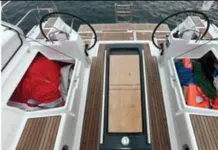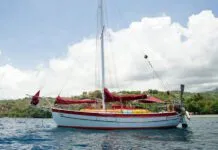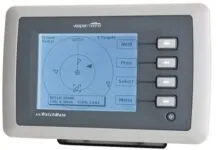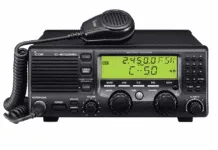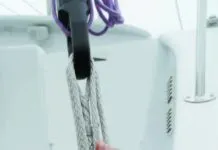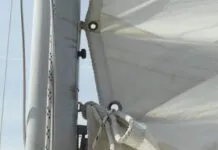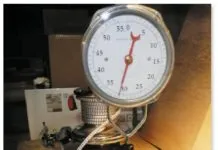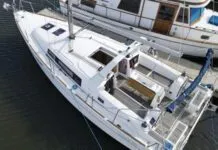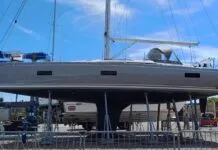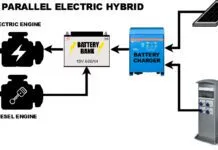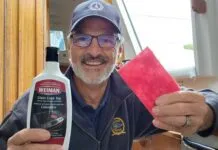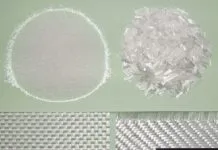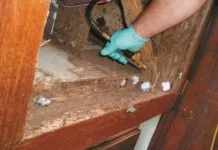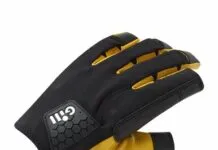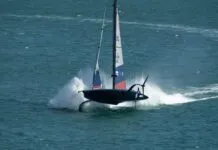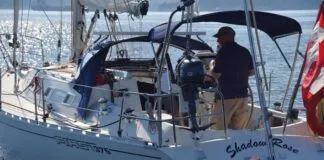Fighting the build-up of barnacles and algae is something mariners have had to do since they first took to the sea in ships. Of course, these are two different organisms and require, as we found out, different means of removal. Barnacles, those ubiquitous crustaceans, secrete a substance-a glue, actually-that enables them to adhere to submerged objects, such as the underside of your boat. The secretion is so effective, in fact, that the navy spent years trying to isolate and duplicate it. Algae, on the other hand, can mean a variety of plants, including kelp and seaweed. Aggravating enough in saltwater, algae is even more of a problem in freshwater.
Here we take a look at three products designed to help in the fight against these bottom-of-the-food-chain phenomena that nevertheless manage to frustrate we homo sapiens.
Here is what we tested.
Marsolve
This product is advertised as a barnacle and scale remover. Marsolve is an old product that has been used to treat and clean steam boilers and other water-cooled or operated equipment for years in land-based industry.It recently has been introduced to the marine market. Marsolve is an aqueous organic salt solution that is biodegradable, non-toxic, non-corrosive, and non-flammable when used within its operating limits. Marsolve poses no waste disposal problem because it is biodegradable in any concentration and can be flushed down regular sewer systems. Marsolve also has no special ventilation or respiratory requirements, but eye protection and glove use are recommended for handling.
Marsolve can be used, without negative reaction, with almost any metal. The exceptions are aluminum, magnesium, and some alloys of stainless steel. Dont use concentrated solutions of Marsolve on these metals for long periods of time. Instead, use a 2:1 solution of water and Marsolve for a short period of time. (Note: Marsolve is an electrolyte, which is any liquid-saltwater, for example-that will transfer small electrical currents.)
Marsolve claims to kill the barnacles and mollusks, and dissolve their shells and the glue that holds the shell onto a boat hull or metal part. Flushing the part or system thoroughly with freshwater finishes the job.
Marsolve costs $14.95 per gallon. It is available from its sole distributor, Robert Louis Associates, in 1-, 5-, 30- and 55-gallon non-returnable containers and has a shelf life of about five years.
Aqua-Chem
The second product we tested, Aqua-Chem, also claims to remove barnacles and zebra mussels, plus algae, scum, waterline stains, and other marine stains from all types of boat bottoms and hulls whether made of fiberglass, wood, or metal without attacking or damaging the boats wax, paint or gelcoat. The manufacturers literature says that Aqua-Chem can be used to clean bait wells, remove rust stains from fiberglass, and also to clean head and galley surfaces. The bottles label cautions that copper-painted hulls may turn green and that aluminum-hulled boat owners should test a small area first. The label also states that Aqua-Chem may discolor galvanized or chromed metals, or stainless steel.
Aqua-Chem is a water-based solution that contains inhibited and enhanced hydrochloric acid. Its label states that its environmentally friendly. As for safety warnings, the label also states that it should be kept clear of nylon or rayon.
Users are cautioned to avoid breathing fumes or vapors and to ensure that there is adequate ventilation during product use. Goggles and rubber gloves are recommended.
Aqua-Chem costs $14.95 per quart and is available from its sole distributor, Aqua-Chem International, as well as some marine discount stores. Aqua-Chem has a shelf life of about three years.
Algae Strip
The third product tested is an algae remover called Algae Strip from Aurora Marine Industries, Inc. This product claims to remove algae and waterline stains from fiberglass hulls with a simple wipe-on, rinse-off process. Instructions say that heavy deposits should be removed with a scrub brush before applying Algae Strip.
The bottles label warns that users are to avoid breathing fumes and contact with eyes, skin or clothing. It also states that this product is to be used only on fiberglass because damage may result to other materials or paint, including aluminum hulls and outdrives. (The company markets another product, Algex, especially for aluminum.) The label also cautions users to first test a small spot if Algae Strip is to be used on colored fiberglass.
Algae Strip contains hydrogen chloride and must be shaken well before use and kept from freezing. A 16.5-ounce container of Algae Strip costs $7.95. It is available at West Marine, and has a shelf life of three years.
How We Tested
We took three heavily barnacle-covered fiberglass panels and three heavily algae-covered fiberglass panels (failures from our yearly bottom paint tests) and let them dry for a few months so the deposits would be harder to remove. Then we treated one barnacle and one algae panel with each of our three test products. We decided to use all three products on both algae and barnacle panels because even though two of the products do not claim to remove both barnacles and algae, we wanted to see what the results would be anyway.
We put our three test solutions-all at full strength-into separate all-plastic spray bottles and sprayed them onto their two test panels; one for barnacles and one for algae. We didnt use a brush or any other means to loosen up the deposits. We just sprayed the solutions on and then waited about five minutes before spraying the panels again. We applied seven coats to the barnacle panels and five coats to the algae panels. We then hosed off all the panels with a spray-nozzled hose and recorded the results.
What We Found
In the barnacle test, Aqua-Chem was the clear winner. It removed almost all the barnacles from the barnacle test panel. However, it did no better at removing algae than Marsolve, though it claims to work on algae.
Marsolve did very well in the barnacle test, although not quite as effective as Aqua Chem. It removed most of the barnacles from our test panel, but did nothing to remove algae from that test panel. This was not a big surprise since it doesn’t claim to work on algae.
Our third product, Algae Strip, did a great job of removing algae, taking the panel down to clean fiberglass while not removing the paint. (Wed recommend a test spot as recommended by the manufacturer before using on your boat anyway.) And true to its label, it did nothing to clean up the barnacles.
Bottom Line:
Algae Strip is the best algae remover of our test. In fact, it was the only one to effectively remove algae. Aqua-Chem was the best barnacle remover in this test, although Marsolve also did a very good job. Marsolve is the least expensive product, so if you need a large quantity, it would pay to seek it out.
Unfortunately, none of the products worked well on both barnacles and algae, meaning youll have to purchase two separate products to thoroughly clean a badly fouled surface.
Contacts- Marsolve, Robert Louis Associates, 85 Shelter Rock Road, Danbury, CT 06810, 203/ 790-0000. Aqua-Chem International, 24101 Perdido Beach Blvd., Orange Beach, AL 36561, 800/579-0786, fax: 334/974-2179. Algae-Strip, Aurora Marine Industries, 7015 Ordan Dr., Mississauga, Ontario, Canada L5T1Y2;905/564-4995.



